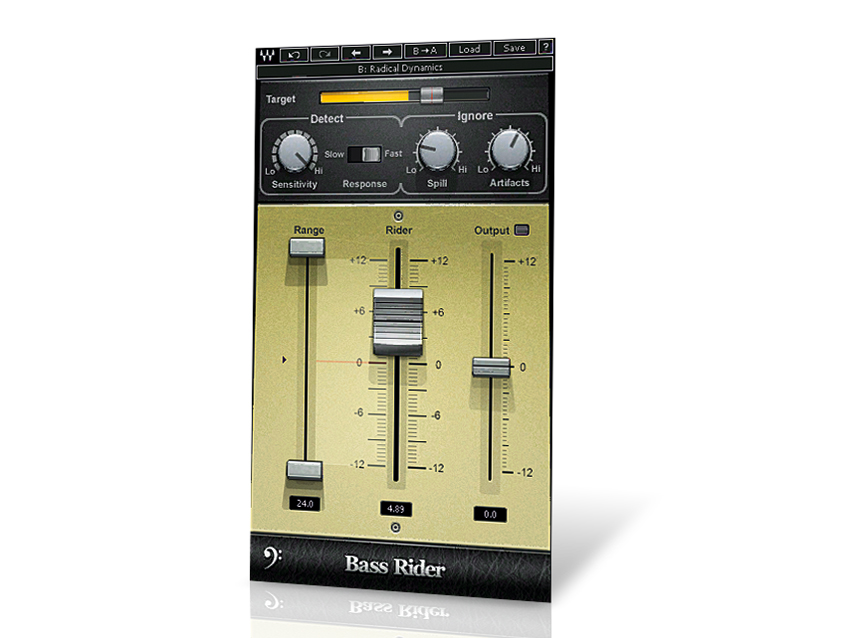MusicRadar Verdict
A viable alternative to compression and gain automation for 'live' bass parts that saves time and sounds great.
Pros
- +
Easy to use; works great on clean bass; can save a lot of time; useful when re-amping; improves a mediocre performance.
Cons
- -
Of limited use on synth bass and compressed/distorted bass.
MusicRadar's got your back
More often than not, the low end is the hardest thing to get right in a mix.
The treatment of bass instruments during mixdown is of utmost importance if you want your tracks to bring it in terms of sheer heft and low-end articulation. Bass is usually tamed with compression, but compressors can alter the character of a sound in addition to constraining its level.
"Ultimately, Bass Rider managed to follow everything we threw at it with ease, dramatically improving mediocre performances and further cementing already solid ones."
Overdoing it leads to a lack of punch and 'smearing' of the low registers, while not enough can leave your mix without the strong foundation it demands. It's quite a balancing act!
An alternative to compression is the fader ride, whereby the gain level is manually adjusted on a note-by-note basis - a sort of manual approach to compression. While the ability to edit fader automation data in your DAW gives you incredible accuracy, this technique is time-consuming and fiddly. If only there was an easier way…
Enter Bass Rider, a plug-in in VST, AU, RTAS and TDM formats for Mac and PC. It's very similar to Waves' Vocal Rider plug-in but optimised for… well, bass sounds.
While the fundamental aims of the two plug-ins are the same (ie, volume levelling), Vocal Rider encourages you to write its movements into the host track as automation via a set of dedicated controls, while Bass Rider works entirely 'on the fly', with no automation-writing functionality to be found.
The GUI is compact and straightforward, comprising Range, Rider and Output sliders, aswell as Detect and Ignore sections, in which you adjust how quickly Bass Rider reacts to the incoming signal and determine to what extent extraneous noises (string squeaks, etc) should be ignored. Most important, though, is the Target meter/fader combination at the top, which is where the bass riding begins…
Want all the hottest music and gear news, reviews, deals, features and more, direct to your inbox? Sign up here.
Ride 'em, cowboy
Correctly setting the Target fader is crucial to getting Bass Rider riding properly - the best results are obtained when it's set so that the incoming bass signal peaks just above (ie, to the right of) the fader position.
With that sweet spot established, the Rider fader is adjusted on a note-by-note basis, attenuating loud notes and boosting quiet ones. Set it wrongly and you'll end up with constant gain boosts or cuts - finding the right setting is essential.
The Range controls define how heavy-handed Bass Rider is in its adjustments, from subtle refinements of 2dB each way, to huge jumps of up to 12dB (which can still come off sounding reasonably natural). While the default setup is a great starting point, we had to turn the Sensitivity knob up and switch the Response to Fast to accurately track more frantic fingerstyle playing.
Ultimately, though, Bass Rider managed to follow everything we threw at it with ease, dramatically improving mediocre performances and further cementing already solid ones.
Bass reaction
But with many different kinds of bass out there, can Bass Rider really handle them all, as Waves claims? We found it most effective on animated transient-heavy bass sources, as opposed to drones or monotonous, rhythmically flat sounds.
With electric, acoustic and double bass sources, Bass Rider shines, deftly levelling the volume and bringing out desirable subtleties and nuances. There are definite advantages here over compression alone, and truly great sounds can be achieved by using the two together.
Synth bass programmers already have plenty of control over note dynamics within their instrument; but for dynamically wild patches, Bass Rider can improve matters far quicker than a lot of manual MIDI editing.
Bass parts that are already processed with compression and/or distortion will have decreased dynamic range, so Bass Rider isn't as effective as it is on unprocessed sounds.
If you already own Vocal Rider, then you can use it on bass and get reasonable results, but, being tuned to bass sounds specifically, Bass Rider tracks them better and responds much more naturally. It's of most benefit to electric bass recorded via DI or direct from a relatively clean-sounding amp.
Bass Rider's not for everyone, certainly, but it is a very useful plug-in that admirably succeeds in its goal of providing a functionally effective and sonically impressive alternative to bass compression or fader automation. Phew!
Computer Music magazine is the world’s best selling publication dedicated solely to making great music with your Mac or PC computer. Each issue it brings its lucky readers the best in cutting-edge tutorials, need-to-know, expert software reviews and even all the tools you actually need to make great music today, courtesy of our legendary CM Plugin Suite.

